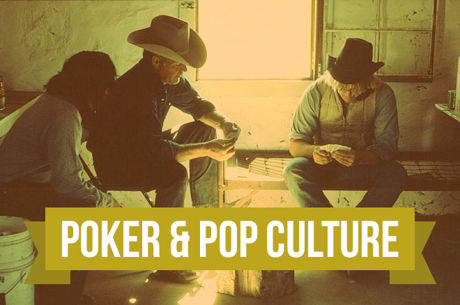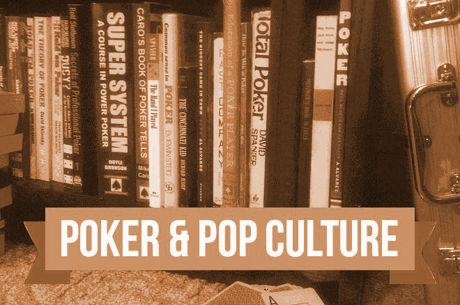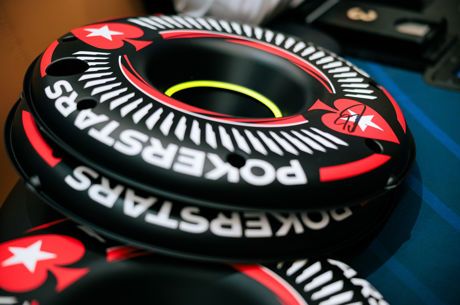Poker & Pop Culture: Poker in the Trenches During WWI
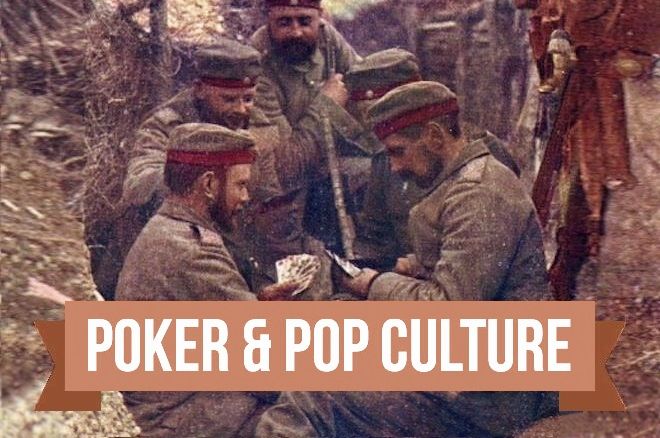
We've discussed before the prominence of poker among the soldiers who fought on both sides of the Civil War. Indeed, one consequence of the battle between the North and South was the further spread of poker throughout the country, with survivors carrying the game back from camps and battlefields to their respective homes.
Card-playing continued to be a significant part of soldiers' experiences during subsequent wars, with World War I — a.k.a. the "Great War" — similarly fostering the spread of poker on a global scale.
Poker and Propaganda
Coinciding with WWI's centennial, the National Playing Card Museum in Tahout, Belgium (i.e., the Nationall Museum van de Speelkaart) hosted an exhibition showcasing the prominent place of poker and card playing among European soldiers during the First World War.
Among the highlights of the exhibition were examples of the many card decks used by German soliders during WWI. According to curator Filip Cremers, "production of these decks reached the astronomical number of one million by the final year of the war."
The decks not only gave soldiers a way to pass considerable stretches of downtime while in the trenches, but served propagandistic purposes as well.
The cards "depicted German war heroes, famous generals and battle scenes," explains Cremers. Some also featured unflattering cariacatures of their opponents from the Allies' side, including Russian Tsar Nicholas II, Serbia's King Peter, and the United Kingdom's First Lord of the Admiralty Winston Churchill.
The exhibition additionally included decks used by Americans once they entered the fray in 1917.
Some of those decks featured flags and colors indicating who the Allied forces were. Others furthered the U.S. soldiers' education by including French phrases and song lyrics, introducing some basic vocabulary to the English-speaking men to help as they fought alongside the French and Belgians.
Bets and Bluffs in Between Battles
The British likewise took cards with them into battle. Telling of the difficult conditions of trench warfare in his diary, British soldier George F. Wear describes himself fighting in France in the summer of 1916 while enduring frequent German shelling and engaging in intermittent battles.
Eventually Wear reaches a point where his initial fears about coming to harm had lessened thanks to danger's constant proximity. In spite of being fired upon constantly, he describes "spending most of the night playing poker and vingt-et-un, drinking enormous quantities of whisky, cursing the War, and wondering if we should ever go on leave."
Another famous WWI participant was future president Harry Truman, who like Wear would find poker a welcome way to pass the time when not in action.
Truman was already in his early 30s by the time of WWI. He would be part of the American Expeditionary Forces in France in 1918 where he served as a captain. Truman was already an avid player by then, and David McCullough explains in his biography of Truman how he played poker frequently with other soldiers during the evenings.
Later in Verdun following the armistice in November, Truman had a long wait before being able to return home. "To keep from going crazy we had an almost continuous poker game," tells a friend of Truman's, a fellow Missourian with whom he was encamped.
The poker-playing of American soldiers like Truman during WWI's late stages was relevant to the game's international growth as well. Much as the Civil War stimulated poker's popularity throughout the U.S., Americans carrying the game with them to Europe helped further fuel the game's subsequent spread by among those with whom they fought (and played).
Drawing Connections Between Poker and Warfare
Of course, the metaphorical connections between poker and war are endless, with many having noted before how much terminology is shared between the two forms of conflict.
Chips are "ammunition" with which players "fire" bets, actions which are variously described as "pulling the trigger" or "taking a stab." Players also fire multiple "bullets" in reentry tournaments — or have to, at least, if they aren't dealt "bullets" (aces) often enough. We also might play a hand "under the gun," go all in on the flop with a "gutshot," then find ourselves "drawing dead" by the turn.
That's not even getting into the many analogies between poker strategy and warfare, between which many tactics are shared — especially bluffing. David Apostolico has written a couple of books exploring such connections — Tournament Poker and the Art of War applying Sun-Tzu's famous treatise to poker, and Machiavellian Poker Strategy doing something similar with The Prince.
Such connections were being made amid the run-up to and during WWI. Prefiguring the war to come, in early 1908 cartoon appeared in the British weekly Punch that suggested the affinity between poker and international conflict.
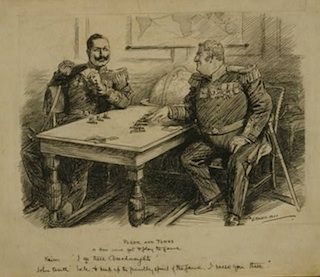
Titled "Poker and Tongs; or, how we've got to play the game," the cartoon by Leonard Raven-Hill was occasioned by the ongoing and increasingly heated arms race for naval supremacy between Britain and Germany.
Two generals are shown sitting with cards in hand, but with miniature naval vessels on the table instead of chips. One, Kaiser Wilhelm II, speaks first, declaring "I go three Dreadnoughts," a reference to the battleship recently introduced by the Royal Navy.
John Bull (a personification of Britain dating back to the early 18th century) is his opponent, and he responds "Well, just to show you there's no ill-feeling, I raise you three."
As the title suggests, the growth of the German navy had forced the U.K.'s hand (to employ a poker analogy), with the stakes between the two powers being subsequently raised.
Once the war began, another famous cartoon appeared in 1915 depicting the Kaiser with bloody hands playing "His Last Card," shown as the jack of spades with a picture of Ferdinand I, the ruler of Bulgaria who had just signed a treaty with Germany and attacked Serbia. (The image was reproduced in French decks as a morale-booster, suggesting Germany's vulnerability.)
Though WWI was described at the time as "the war to end all wars," we well know that would hardly prove the case. And as wars continued throughout the 20th century, so, too, would poker and card playing continue to feature prominently in the stories they produced.
From the forthcoming "Poker & Pop Culture: Telling the Story of America's Favorite Card Game." Martin Harris teaches a course in "Poker in American Film and Culture" in the American Studies program at UNC-Charlotte.
Images: "German soldiers playing cards on the Western front, July 1916," National Playing Card Museum; "Poker and Tongs," Punch, Library of Congress.


